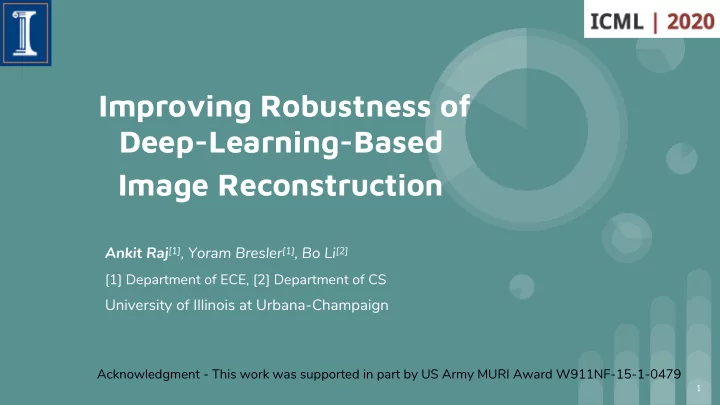

Improving Robustness of Deep-Learning-Based Image Reconstruction Ankit Raj [1] , Yoram Bresler [1] , Bo Li [2] [1] Department of ECE, [2] Department of CS University of Illinois at Urbana-Champaign Acknowledgment - This work was supported in part by US Army MURI Award W911NF-15-1-0479 1
Overview Deep-learning-based inverse problem solvers recently proven to be sensitive to perturbations. ● Instability stems from the combined system (deep network + underlying inverse problem). ● Co Contributions: Proposed a min-max formulation to build a robust model. ● Introduced an auxiliary network to generate adversarial examples for which the image recon ● network tries to minimize the recon loss. ● Si Significant improvement of robustness using the proposed approach over other methods for deep networks. Theoretically analyzed a simple linear network - found that min-max formulation results in ● singular-value filter regularized solution mi mitigating the effect of adversarial examples due to ill ill-co conditi tioning . 2
Attacks on DL-based Inverse problems solvers [1] Recent work shows deep learning typically yields unstable methods ● for image reconstruction. Evaluated 3 different types of instabilities: ● Tiny perturbation in the image domain results in severe ○ artifacts. Small structural change which is not recovered. ○ Increasing number of samples does not improve recovery. ○ [1] Antun et al. On instabilities of deep learning in Image Recon and the potential costs of AI , PNAS ‘20 3
Instabilities to perturbation in Image-Domain [1] Attack is obtained by solving: 4
Modeling perturbations in x or y-domain ? Our argument - study of perturbation in x-domain is sub-optimal for inverse problems. RE REASO SON - 1 Perturbation in x may not be able to model all possible perturbations in y. ● - perturbation in x leads to perturbation in y. ● Constrains the perturbation to be in Range( A ). ● Not possible to model all possible perturbations when A does not ● have full-row rank. 5
Reason-2: Effect of Ill-Conditioning Perturbation in x: Perturbation in y: For ill-conditioned measurement operator, an ideal inverse can be highly vulnerable to even a small perturbation in the measurement-space, which is totally missed in the x-space formulation. 6
Reason-3: Measurement Operator Perturbations ● Suppose there is mismatch between A used in training , and the A actually generating the measurements. ● Let actual perturbation in y-space. ● Typically , which the x-space formulation can’t model. 7
Adversarial Training Framework for IR ● Ideal framework for adversarial training. ● Very expensive during training. ● Finding perturbation specific to each training sample. A sub-optimal approximation Tractable training. ● Finding perturbation common to many training samples. ● Not the ideal scheme. Why? ● 8
Desiderata for Adversarial Training ● Perturbation specific to the sample. ● Reasonably feasible to train in adversarial way. Idea: model this perturbation using a deep network Adv Advantages: This approach eliminates the need to solve the inner-max using ● hand-crafted method. Since G(.) is parameterized, and takes y as input, a well-trained G ● results in optimal perturbation, given y. 9
Modified Objective True Recon. term Bounded perturbation term Adversarial term 10
Training Schematic 11
Robustness Metric Determines the reconstruction error due to the worst-case ● additive perturbation over the --ball around the measurement. Solved empirically using Projected Gradient Ascent. ● Smaller value implies more robust network 12
Experiments - Comparison Benchmarks End-to-end Training (No Regularization): L2-norm Regularization (“weight decay”): Parseval Networks: 13
Qualitative Results : MNIST Co Compressed Sensing (with Gau aussian an Meas asurement Mat atrix): Recon using deep CN CNN Proposed Method 14
Qualitative Results: CelebA Proposed Method 15
Quantitative Results MNIST CelebA 16
Experiment on Real X-ray Images ● Implemented the proposed adversarial training algorithm on FBPConvNet [2] for low-dose CT reconstruction. ● For fast computation of forward projection (Radon transform) and filtered backprojection (FBP - numerical inverse Radon transform) on GPUs, we used the Astra toolbox [3]. ● Dataset: Anonymized clinical CT images [4]: 884 slices for training, and 221 slices for evaluation. ● Measurements obtained by computing parallel-beam projections of the CT images at 143 view angles uniformly spaced on [0, 180]. [2] Jin et al. Deep CNN for Inverse Problems in Imaging, IEEE Trans. On Image Proc., 2017 [3] Van Aarle, W., et al. "Fast and flexible X-ray tomography using the ASTRA toolbox." Optics Express 2016 [4] Prof. Michael Vannier, Dept. Radiology, Univ. of Chicago, personal communication. 17
Qualitative Results for CT Recon Proposed Method 18
Theoretical (6) Analysis Assumptions+Notation: ● is a one-layer feed-forward network with no non-linearity i.e. = E x = COV( ) x I ( ) 0 ● Data is normalized i.e. , ● Matrices A and B have SVDs: ● S is a diagonal matrix with singular values ordered by increasing magnitude Th Theorem: If the above assumptions are satisfied, then the optimal B obtained by solving (6) is a modified pseudo-inverse of A , with and Q a filtered inverse of S : { } 1 n s q with largest entry of multiplicity m that depends on and i m = i 19
Revisit: simple ill-conditioned case Modified pseudo-inverse after adv. training: Important points: ● For unperturbed y, true inverse better than modified inverse. ● But for the true inverse, small perturbation results in severe degradation ● Trade-off behavior 20
Results for relatively ill-conditioned DCT sub-matrix MNIST CelebA 21
Take-home ● Conventionally trained (and even regularized) deep-learning-based image reconstruction networks are vulnerable to adversarial perturbations in the measurement. ● Proposed a min-max formulation to build robust DL-based image reconstruction. ● To make this tractable, we introduced an auxiliary network to generate adversarial examples for which the image recon network tries to minimize the recon loss. ● Analyzed a simple linear network - found that min-max formulation results in singular- value filter regularized solution mitigating the effect of adversarial examples due to ill- conditioning of the measurement operator. ● Empirical results show that behavior depends on the conditioning of the measurement operator. 22
Recommend
More recommend